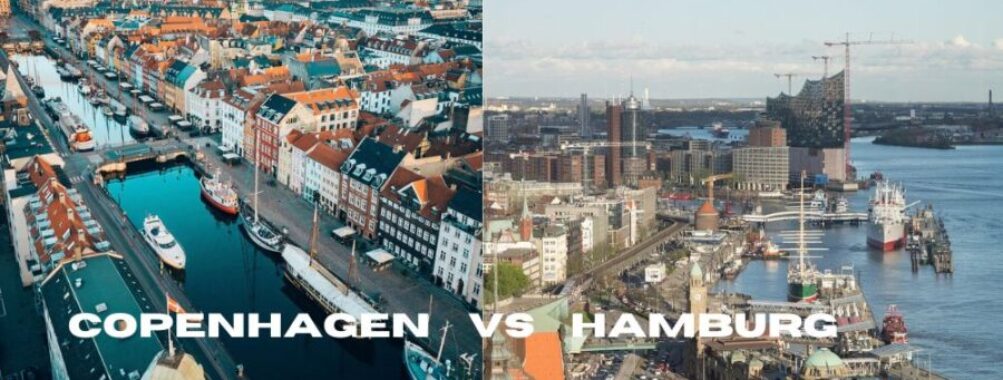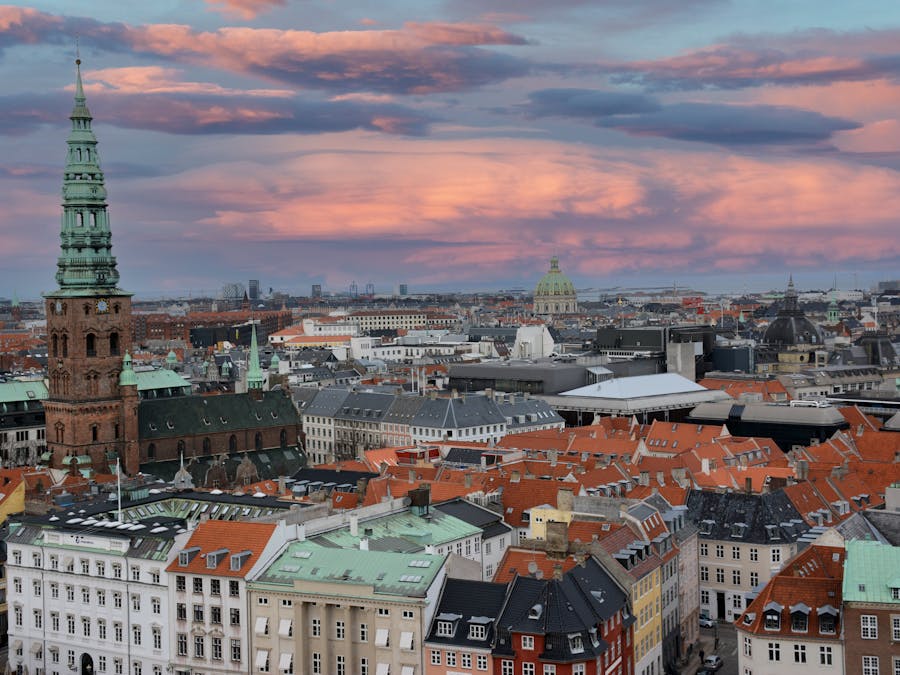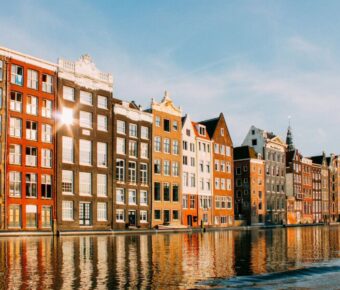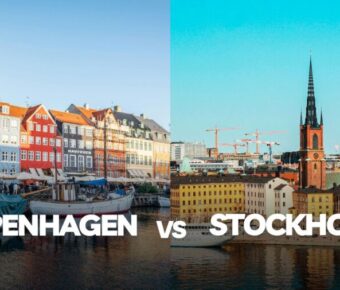
Copenhagen vs Hamburg: Which Nordic City Offers Better Value in 2025
Copenhagen and Hamburg stand as two of Northern Europe’s most captivating cities, each with its own distinct charm and character. These port cities blend historic maritime heritage with modern urban life, making them popular stops for travelers exploring the region.
Most people stay 2-5 days in the Danish capital compared to 1-3 days in the German port city. While Copenhagen offers more tourist activities, Hamburg makes up for it with its raw authenticity and lower costs – living expenses in Copenhagen are 23% higher than in Hamburg.
Both cities deserve a spot on any Northern European travel itinerary. Copenhagen shines with its bike-friendly streets, world-class food scene, and Danish design, while Hamburg draws visitors with its striking architecture, vibrant nightlife, and rich maritime culture. The choice between them often comes down to personal interests and travel style.
Contents
- Geographical and Cultural Overview
- Location and Climate
- Language and Society
- Economic Comparison
- Job Market Overview
- Major Industries
- Living Standards
- Housing Market Contrast
- Healthcare Services
- Education System Analysis
- Cost of Living Comparison
- Transportation and Connectivity
- Public Transport Systems
- Walkability and Biking
- Leisure and Entertainment
- Nightlife and Dining
- Museums and Historical Sites
- Festivals and Events
- Traveler’s Experience
- Tourist Hotspots
- Off the Beaten Path
- Safety and Accessibility
- Frequently Asked Questions
- What distinguishes the cultural scenes between Copenhagen and Hamburg?
- How does the quality of life compare in Copenhagen vs Hamburg for expatriates?
- What are the main differences in the dining experiences offered by Copenhagen and Hamburg?
- In terms of transportation options, how do Copenhagen and Hamburg differ for tourists?
- How do job market opportunities in Copenhagen contrast with those in Hamburg for professionals seeking employment?
- What are the unique attractions or events in Hamburg that a traveler won’t find in Copenhagen?
- More Travel Guides
Geographical and Cultural Overview
Copenhagen and Hamburg showcase distinct geographical settings and cultural identities that shape their unique urban characters. Both cities blend historic maritime heritage with modern metropolitan lifestyles.
Location and Climate

Copenhagen sits on Denmark’s eastern coast, spread across the islands of Zealand and Amager. The city enjoys a mild coastal climate with cool summers and relatively mild winters. Water plays a big role here – the city faces the Øresund strait, connecting to Sweden.
Hamburg stretches along the River Elbe in northern Germany, about 100 kilometers from the North Sea. Its position made it a major port city. The climate brings more rainfall than Copenhagen, with slightly warmer summers and similar winter temperatures.
Both cities feature numerous canals and waterways. Hamburg’s port remains one of Europe’s largest, while Copenhagen’s harbor has transformed into a mix of working port and recreational spaces.
Language and Society
Copenhagen’s society centers on Danish culture, though English is widely spoken. The city embraces the Danish concept of hygge – creating cozy, comfortable social spaces. Bikes rule the streets here, with cyclists making up a huge part of daily traffic.
Hamburg mixes German efficiency with northern maritime culture. While German dominates, the city’s trading heritage makes it quite international. The local dialect, Hamburger Platt, adds character to daily life.
Each city puts its own spin on work-life balance. Copenhagen’s residents enjoy shorter work hours and extensive social benefits. Hamburg combines traditional German work values with a laid-back port city vibe.
The art scenes differ too. Copenhagen leans toward sleek Nordic design, while Hamburg’s creative spirit shows in its street art and alternative neighborhoods like St. Pauli.
Economic Comparison
Copenhagen and Hamburg demonstrate significant economic differences, with Copenhagen showing higher living costs while Hamburg maintains strong industrial growth. The two cities feature distinct job markets and industry concentrations that shape their economic landscapes.
Job Market Overview
Both cities boast low unemployment rates and strong career prospects. Copenhagen’s job market excels in tech, life sciences, and creative industries. The average salary in Copenhagen runs about 23% higher than Hamburg, but living costs eat up more of workers’ paychecks.
Hamburg’s job market centers on maritime, logistics, and manufacturing roles. Workers in Hamburg enjoy better purchasing power – their wages stretch further due to lower living costs. A typical salary in Hamburg needs to be around €5,300 to match a €6,458 Copenhagen income.
Major Industries

Hamburg shines as Europe’s third-largest port city. The maritime sector drives its economy through shipping, shipbuilding, and logistics. The city also leads in aerospace manufacturing, with Airbus maintaining major facilities there. Media and tech companies form another key economic pillar.
Copenhagen’s economy runs on clean tech, pharmaceuticals, and IT. The city has become a major hub for startups and innovation. Maritime industries play a role too, though smaller than Hamburg’s port operations.
The city hosts several global pharmaceutical companies and maintains a growing biotech cluster. Green energy companies, especially wind power firms, make up another fast-growing sector.
Living Standards
Copenhagen and Hamburg offer distinct living standards shaped by their unique approaches to housing, healthcare, and education, with Copenhagen’s higher costs balanced by excellent public services.
Housing Market Contrast

The rental market in Copenhagen comes with steep prices compared to Hamburg, with residents needing about 23% more income to maintain similar living conditions. A typical one-bedroom apartment in central Copenhagen costs around 1,500€ monthly, while Hamburg offers similar units for about 1,200€.
Buying property in Copenhagen’s city center averages 7,000€ per square meter. Hamburg presents more affordable options at approximately 5,500€ per square meter.
Both cities face housing shortages, but Hamburg’s larger urban area provides more options for suburban living. The German city also offers more diverse housing types, from modern apartments to traditional townhouses.
Healthcare Services

Danish healthcare stands out with its universal coverage system, making medical services in Copenhagen easily accessible to residents. Wait times for specialists average 2-3 weeks.
Hamburg’s healthcare system follows Germany’s dual public-private model. The city hosts several renowned medical centers, including the University Medical Center Hamburg-Eppendorf.
Public health insurance costs less in Hamburg, with monthly contributions averaging 15% of gross income. Copenhagen’s system is tax-funded, reflected in higher income tax rates.
Education System Analysis

Copenhagen’s education system emphasizes innovation and practical skills. The University of Copenhagen ranks among Europe’s top institutions, attracting international students with English-taught programs.
Hamburg’s educational landscape features the University of Hamburg and several specialized colleges. The city’s vocational training programs partner closely with local industries.
Both cities offer free public education through university level for EU citizens. International school options are more numerous in Hamburg, though Copenhagen provides better student support services.
Cost of Living Comparison

Living costs in Copenhagen are noticeably higher than in Hamburg. A person needs about €6,457 in Copenhagen to maintain the same lifestyle that would cost €5,300 in Hamburg.
Copenhagen ranks as Denmark’s most expensive city, while Hamburg sits at 6th place in Germany. The price gap between these cities is significant – Copenhagen costs about 23% more than Hamburg for daily expenses.
Food prices show clear differences. A basic lunch with a drink in Copenhagen’s business district costs around 150 Danish kroner (€20), compared to €15 in Hamburg.
Rent takes up a big chunk of expenses in both cities. Copenhagen’s rental market tends to be pricier, which adds to the higher cost of living compared to Hamburg.
Basic goods and services follow this pattern too. From groceries to entertainment, Copenhagen generally demands more from your wallet than Hamburg does.
The silver lining? Both cities offer good value for their quality of life. An average salary after taxes covers about 1.7 months of living expenses in both places, suggesting similar purchasing power relative to income.
Note: Prices and comparisons are based on 2025 data
Transportation and Connectivity
Both cities excel in moving people around efficiently with robust public transit networks and bike-friendly infrastructure that makes getting from point A to point B simple and convenient.
Public Transport Systems

Copenhagen’s metro system runs 24/7 and connects major areas with frequent service. The S-train network branches out to suburbs while buses fill gaps between rail lines. A single ticket costs about $3.67 and gives access to all public transport options.
Hamburg offers an extensive network of U-Bahn (subway) and S-Bahn (suburban rail) lines. The systems run from early morning until late at night with some 24-hour weekend service. Buses complement the rail network.
The travel time between these cities will drop to just 2.5 hours thanks to new rail connections under development. This will make day trips between Hamburg and Copenhagen much easier.
Walkability and Biking

Copenhagen ranks as one of the world’s most bike-friendly cities. Wide, protected bike lanes crisscross the entire city. Nearly half of all trips in Copenhagen happen by bicycle.
The city designed its streets and neighborhoods to prioritize pedestrians and cyclists. Most attractions sit within walking distance of each other in the compact city center.
Hamburg features good walking paths along its many canals and harbor areas. The city keeps expanding its bike infrastructure with new dedicated lanes and bike parking facilities.
Bike sharing programs exist in both cities. You’ll find rental stations near major transit hubs and popular destinations.
Leisure and Entertainment
Both cities offer rich entertainment scenes with distinct cultural personalities. Copenhagen’s modern Nordic flair meets Hamburg’s maritime charm through vibrant nightlife, world-class museums, and year-round festivals.
Nightlife and Dining

Copenhagen’s Meatpacking District buzzes with trendy bars and restaurants in converted industrial spaces. The area hosts popular spots like Jolene Bar and Warpigs Brewpub, serving craft beers and late-night bites.
Hamburg’s famous Reeperbahn in St. Pauli lights up after dark. This 24-hour entertainment district features over 400 venues, from rock clubs to theater shows. The Beatles started their career playing here.
Food scenes differ between the cities. Copenhagen boasts 15 Michelin-starred restaurants and leads the New Nordic cuisine movement. Noma put the city on the global food map.
Hamburg’s fish markets and seafood restaurants showcase its port city heritage. The Schanzenviertel quarter offers casual dining spots and food halls perfect for sampling local specialties.
Museums and Historical Sites

Copenhagen’s National Museum tells Denmark’s story from Viking times to present day. The design-focused Louisiana Museum of Modern Art sits just north of the city, offering stunning sea views.
The iconic Elbphilharmonie concert hall defines Hamburg’s skyline. Its plaza deck gives amazing city views. The Miniatur Wunderland houses the world’s largest model railway.
Both cities preserve maritime history. Copenhagen’s colorful Nyhavn waterfront draws visitors with its 17th-century buildings. Hamburg’s UNESCO-listed Speicherstadt warehouse district shows off Gothic brick architecture.
Festivals and Events

Copenhagen hosts the 10-day Distortion street party each spring, filling different neighborhoods with music and dancing. The Copenhagen Jazz Festival brings over 1,000 concerts each July.
The Hamburg DOM fair happens three times yearly – spring, summer and winter. It’s northern Germany’s biggest fun fair with rides and food stalls.
Reeperbahn Festival transforms Hamburg into Europe’s biggest club festival each September. Over 600 concerts spread across 70 venues showcase new music talent.
Both cities celebrate winter with Christmas markets. Copenhagen’s Tivoli Gardens becomes a magical holiday wonderland. Hamburg sets up markets at its historic Town Hall and harborfront.
Traveler’s Experience
Both cities offer distinct visitor experiences ranging from world-class museums to vibrant food scenes. Each destination shines in its own way, with unique cultural offerings and local character.
Tourist Hotspots

Copenhagen draws crowds to its colorful Nyhavn waterfront, where bright buildings line the canal. The Little Mermaid statue remains an iconic photo spot, though many visitors find it smaller than expected.
Hamburg’s Miniatur Wunderland amazes visitors with its intricate model railways and tiny cityscapes. The massive HafenCity district showcases modern architecture alongside historic warehouse buildings.
Book guided tours in both cities to learn fascinating local history. Copenhagen’s Tivoli Gardens delights with vintage rides and gardens, while Hamburg’s Elbphilharmonie concert hall stuns with its glass waves design.
Off the Beaten Path

Copenhagen’s Christiania offers a glimpse into alternative living, with street art and quirky cafes. The Assistens Cemetery provides peaceful walks where locals jog past Hans Christian Andersen’s grave.
Hamburg’s Schanzenviertel neighborhood buzzes with local energy, filled with street art and indie shops. The Portuguese Quarter serves amazing seafood in simple restaurants tourists rarely find.
Hidden gems include Copenhagen’s Superkilen park with its global collection of urban furniture. Hamburg’s Treppenviertel area in Blankenese features winding stairs between beautiful villas.
Safety and Accessibility

Both cities rank among Europe’s safest destinations. Copenhagen excels with bike-friendly infrastructure and efficient public transport. Most attractions sit within walking distance of the city center.
Hamburg spreads across a larger area but offers excellent U-Bahn and S-Bahn connections. The central train station connects to all major districts and attractions.
Visitors with mobility needs find good accommodation in both cities. Copenhagen leads slightly with more accessible infrastructure and smoother sidewalks.
Both cities provide clear signage in English. Many locals speak English fluently, making navigation simple for international visitors.
Frequently Asked Questions
Both cities offer distinct experiences for visitors and residents, with significant differences in cost of living, cultural attractions, and lifestyle opportunities that shape daily life and travel experiences.
What distinguishes the cultural scenes between Copenhagen and Hamburg?
Copenhagen’s cultural scene centers on modern Nordic design, contemporary art galleries, and innovative theater. The city hosts numerous summer festivals celebrating music and arts in public spaces.
Hamburg’s cultural identity ties strongly to its maritime heritage. The city’s famous Elbphilharmonie concert hall and historic warehouse district showcase a blend of old and new artistic expressions.
How does the quality of life compare in Copenhagen vs Hamburg for expatriates?
Copenhagen ranks higher in quality of life surveys but comes with steeper living costs. A single person needs about €7,253 monthly in Copenhagen compared to €4,900 in Hamburg for similar living standards.
The Danish capital offers excellent healthcare and work-life balance. Its bike-friendly infrastructure and green spaces add to daily life quality.
Hamburg provides more affordable housing options and lower daily expenses. The city’s large expat community makes integration easier for newcomers.
What are the main differences in the dining experiences offered by Copenhagen and Hamburg?
Copenhagen leads in fine dining with its Nordic cuisine revolution. The city’s restaurants focus on seasonal ingredients and creative presentations.
Hamburg excels in seafood offerings and traditional German fare. Street food markets and international cuisine reflect the city’s trading port heritage.
In terms of transportation options, how do Copenhagen and Hamburg differ for tourists?
Copenhagen’s compact size makes it perfect for cycling. The city has extensive bike lanes and an efficient metro system connecting major attractions.
Hamburg relies more on its U-Bahn and S-Bahn networks. The harbor ferries serve as both transportation and tourist attractions.
How do job market opportunities in Copenhagen contrast with those in Hamburg for professionals seeking employment?
Copenhagen offers strong opportunities in tech, design, and sustainable industries. English-speaking jobs are common, though Danish language skills help career growth.
Hamburg’s job market centers on logistics, media, and maritime industries. The city has a growing startup scene with international companies.
What are the unique attractions or events in Hamburg that a traveler won’t find in Copenhagen?
Hamburg’s Miniatur Wunderland houses the world’s largest model railway. The Sunday Fish Market tradition dates back to 1703.
The Reeperbahn entertainment district offers unique nightlife experiences. Meanwhile, Hamburg’s port tours showcase massive container ships and historic sailing vessels.



